
Concept explainers
Calculate the voltage labeled vx in Fig. 7.52, assuming the circuit has been running a very long time, if (a) a 10 Ω resistor is connected between terminals x and y; (b) a 1 H inductor is connected between terminals x and y; (c) a 1 F capacitor is connected between terminals x and y; (d) a 4 H inductor in parallel with a 1 Ω resistor is connected between terminals x and y.
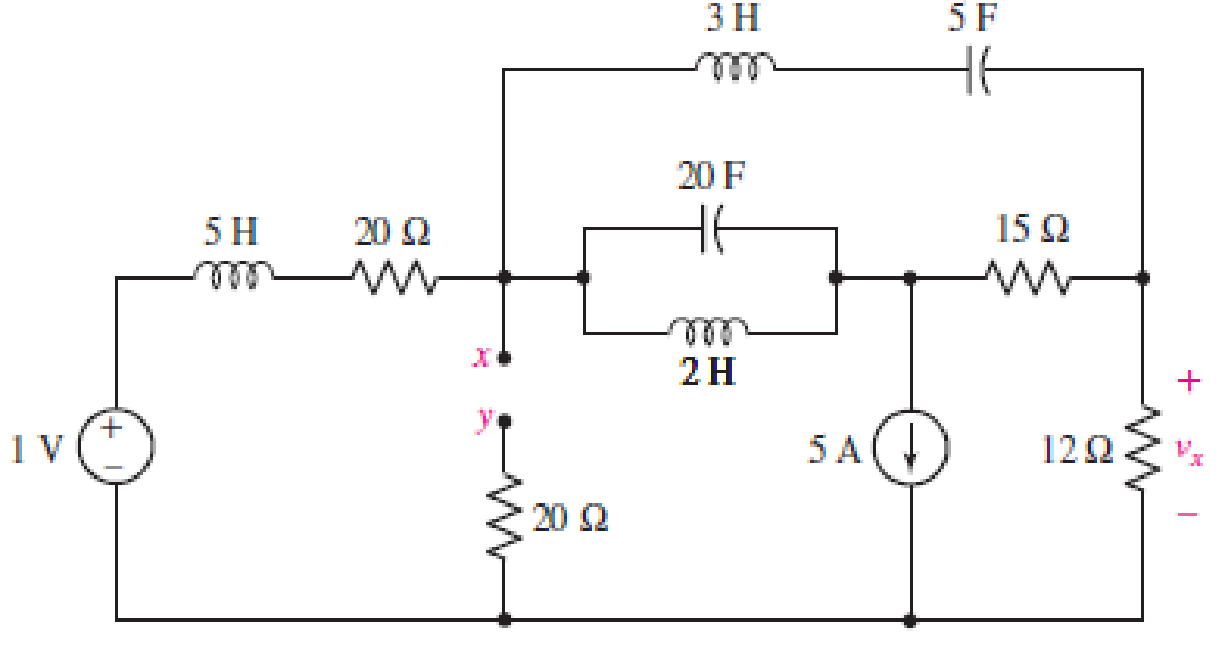
FIGURE 7.52
(a)
Find the voltage
Answer to Problem 29E
The voltage
Explanation of Solution
Given data:
Value of resistance connected between terminals
Calculation:
The redrawn circuit is shown in Figure 1 as follows:
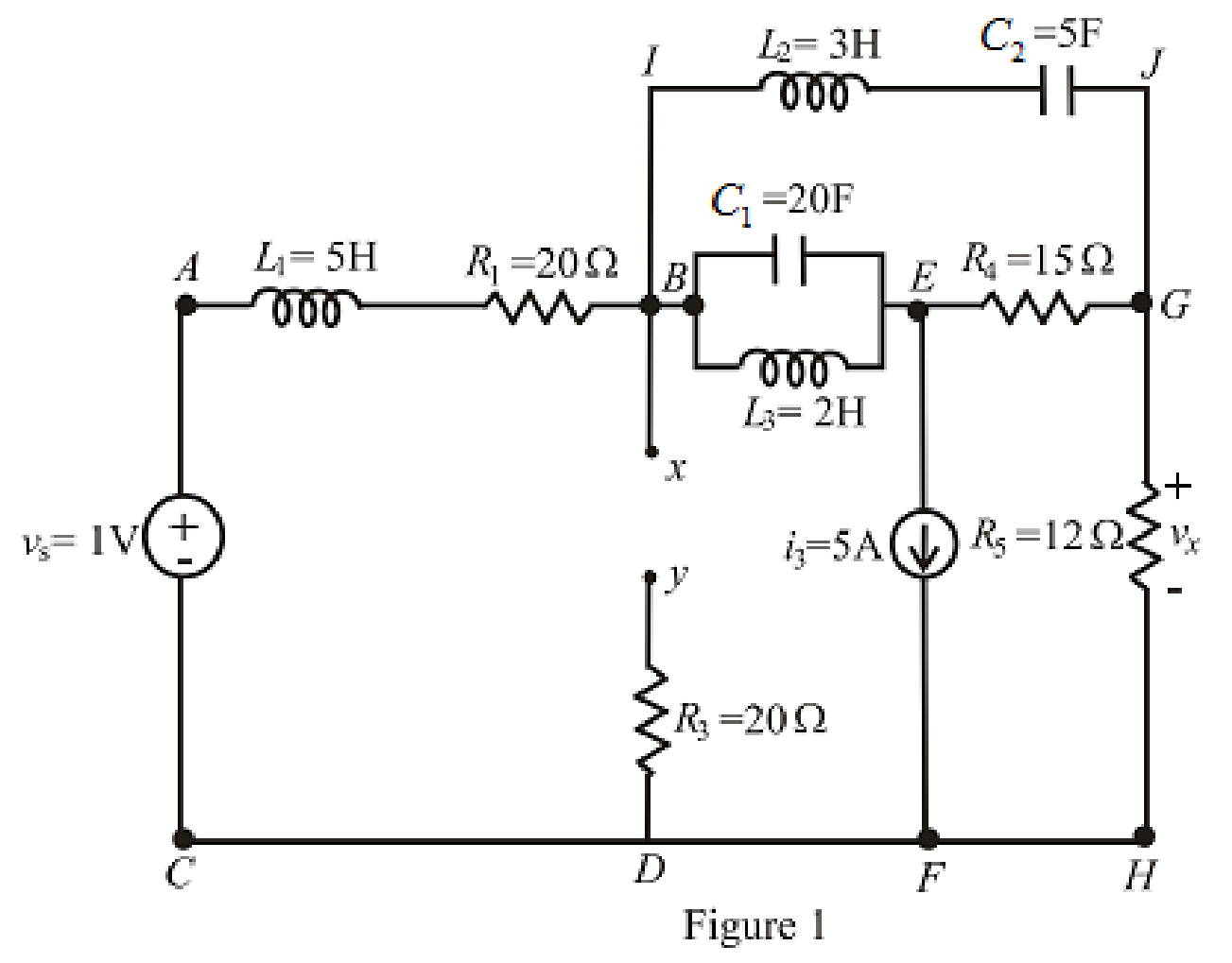
Here,
The redrawn circuit is shown in Figure 2.
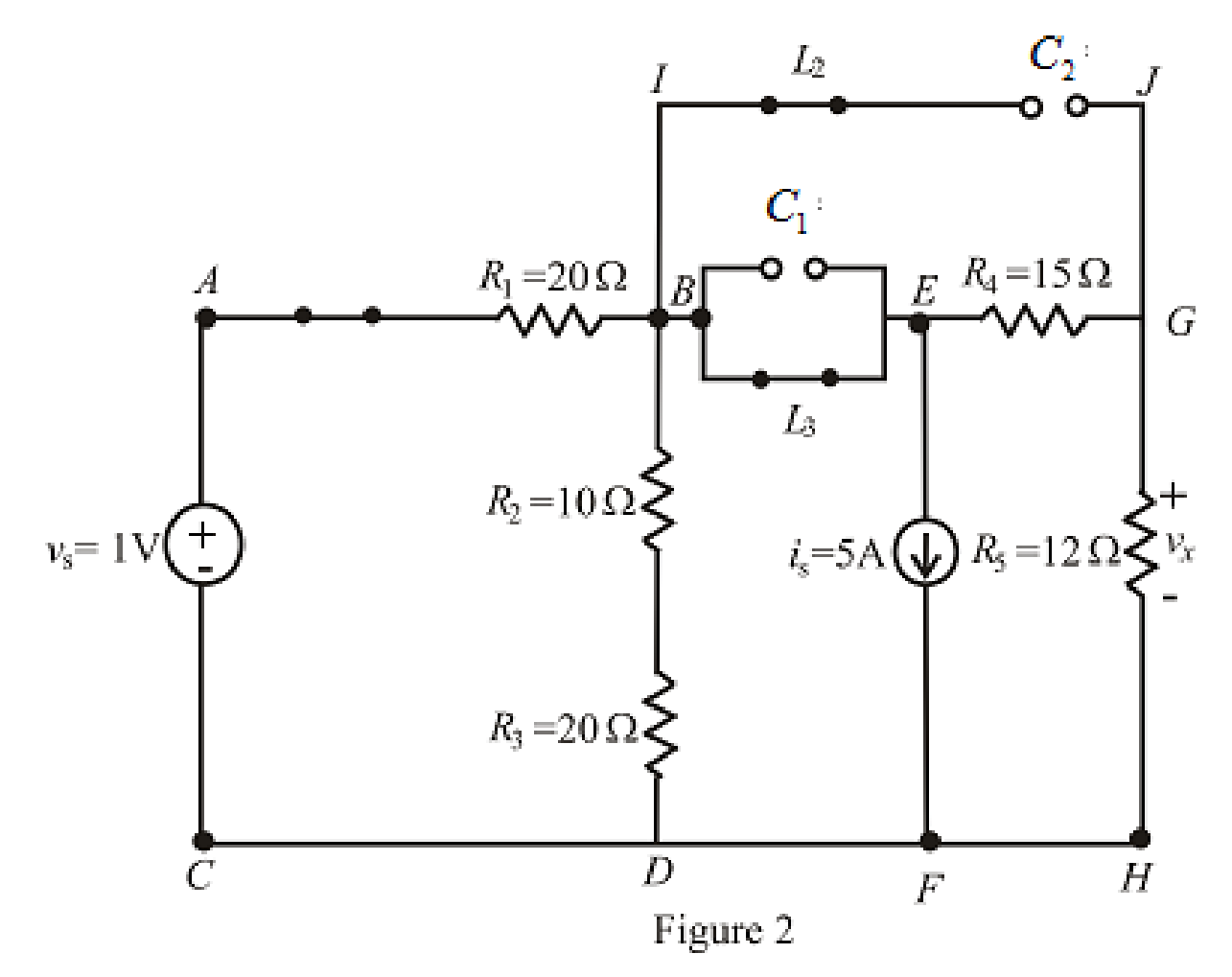
Refer to the Figure 2:
When steady state is reached, all the inductors connected are short circuited and all the capacitors connected are open circuited.
The equivalent resistance for series combination across branch is as follows:
Substitute
The redrawn circuit is shown in Figure 3 as follows:

Refer to the redrawn Figure 3:
The expression for the nodal analysis at node voltage
Here,
The expression for the current across the resistance
The expression for the voltage across the resistance
The current across the resistances
Substitute
Solve for
Substitute
Substitute
Conclusion:
Thus, the voltage
(b)
Find the voltage
Answer to Problem 29E
The voltage
Explanation of Solution
Given Data:
Value of inductor connected between terminals
Calculation:
The redrawn circuit with inductor connected across branch
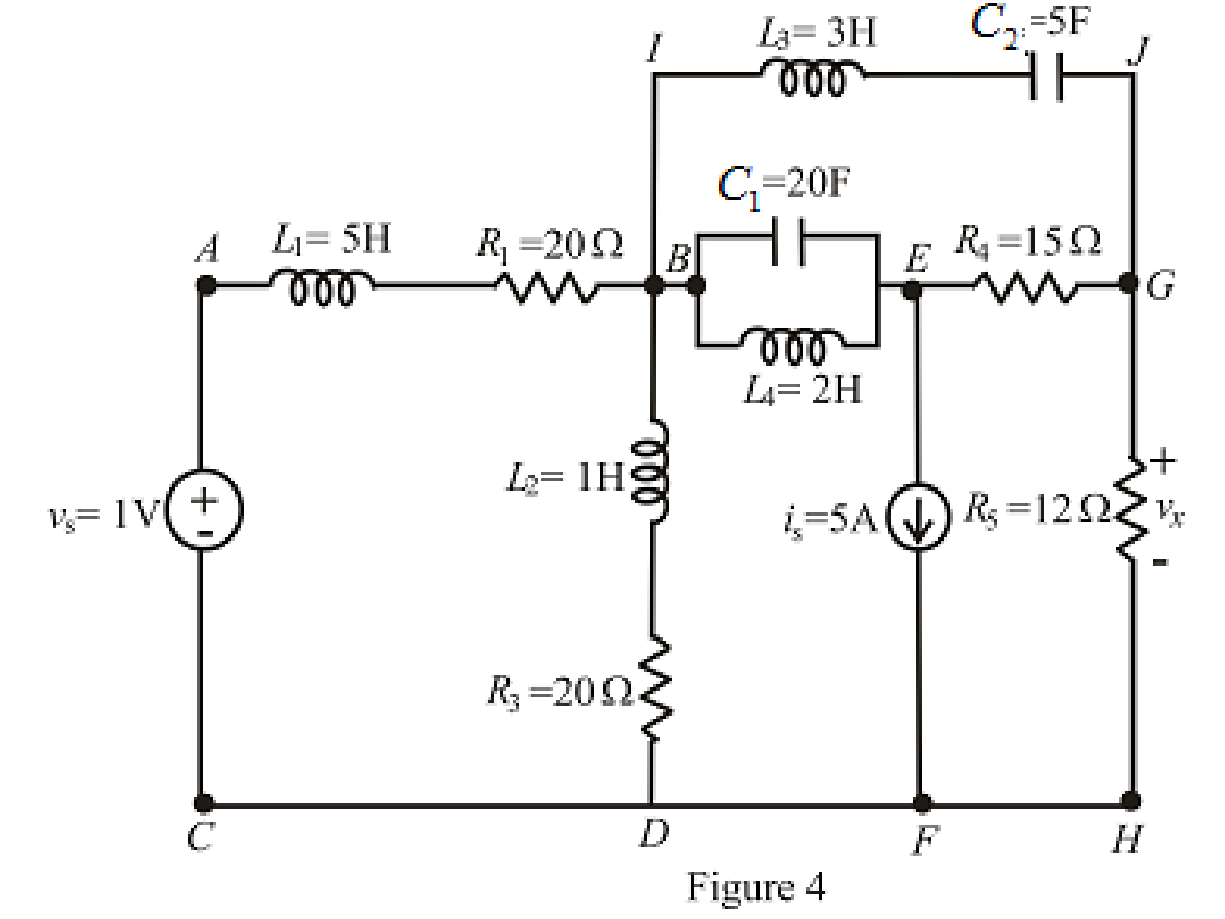
The redrawn circuit is shown in Figure 4 as follows:

Refer to the Figure 5:
When steady state is reached, the inductor connected across branch
The redrawn circuit is shown in Figure 6 as follows:
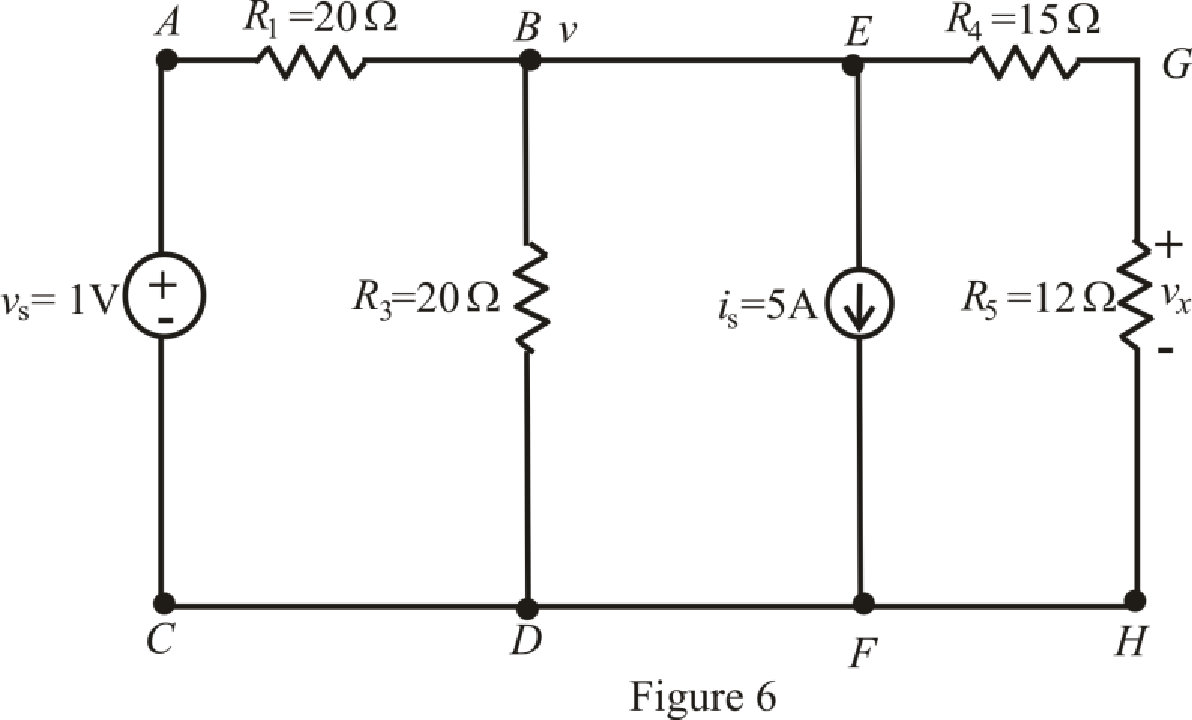
The expression for the nodal analysis at node voltage
The expression for the current across the resistance
The expression for the current across the resistance
The current across the resistances
Substitute
Solve for
Substitute
Substitute
Conclusion:
Thus, the voltage
(c)
Find the voltage
Answer to Problem 29E
The voltage
Explanation of Solution
Given data:
Value of capacitor connected between terminals
Calculation:
The redrawn circuit of capacitor connected across branch
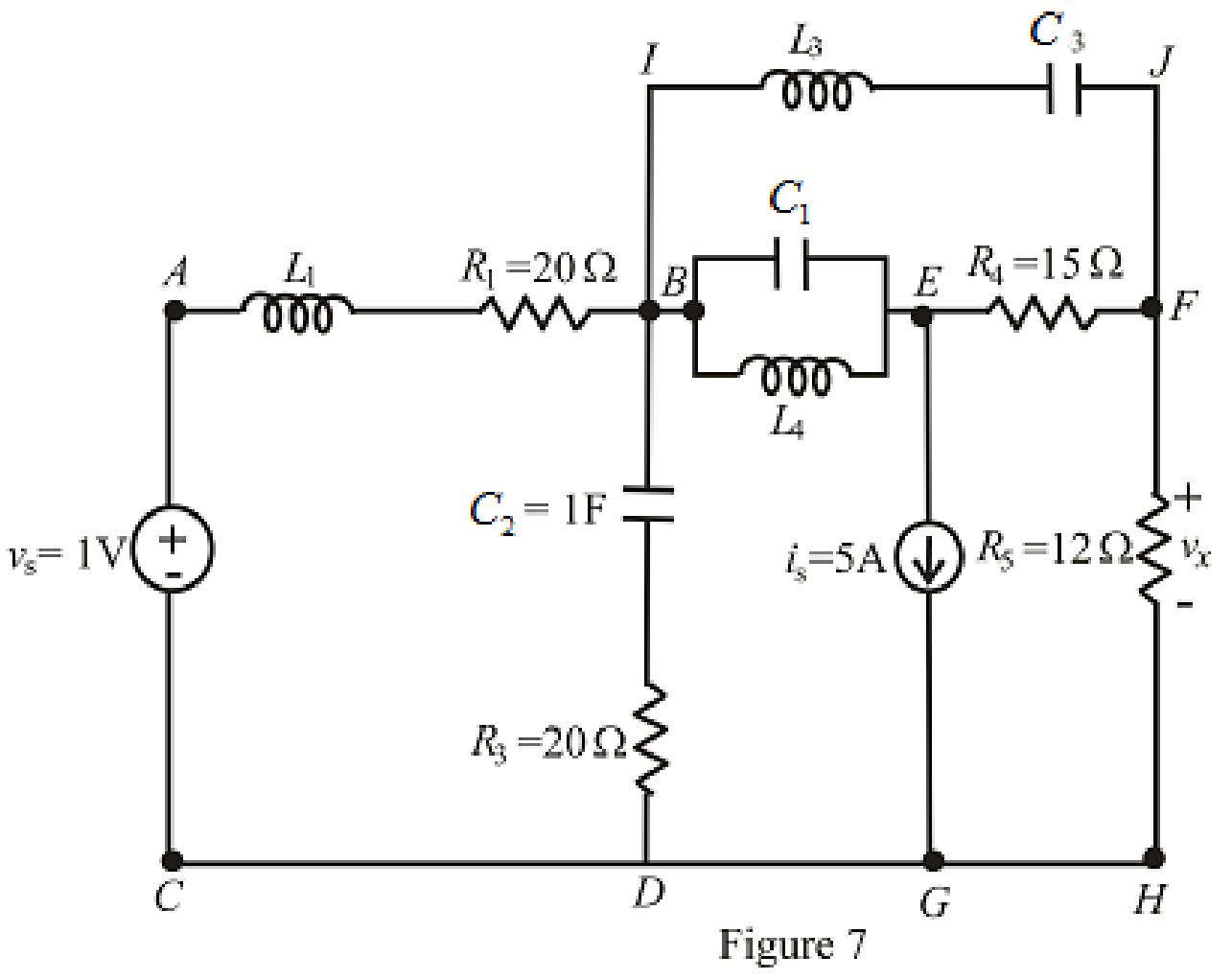
Refer to the redrawn Figure 7:
The redrawn circuit is shown in Figure 8 as follows:
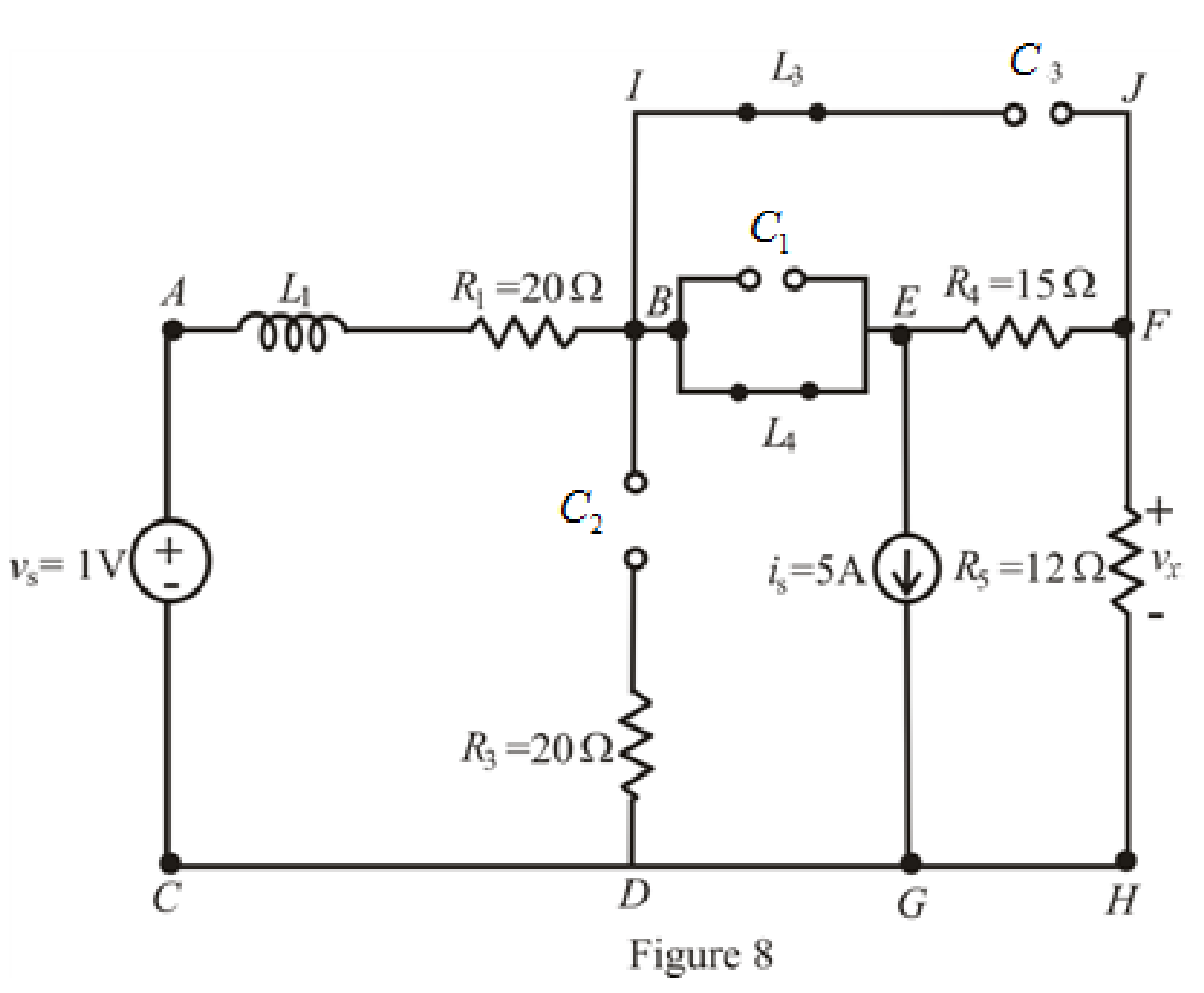
When steady state is reached, thecapacitors connected across branch
The redrawn circuit is shown in Figure 9 as follows:
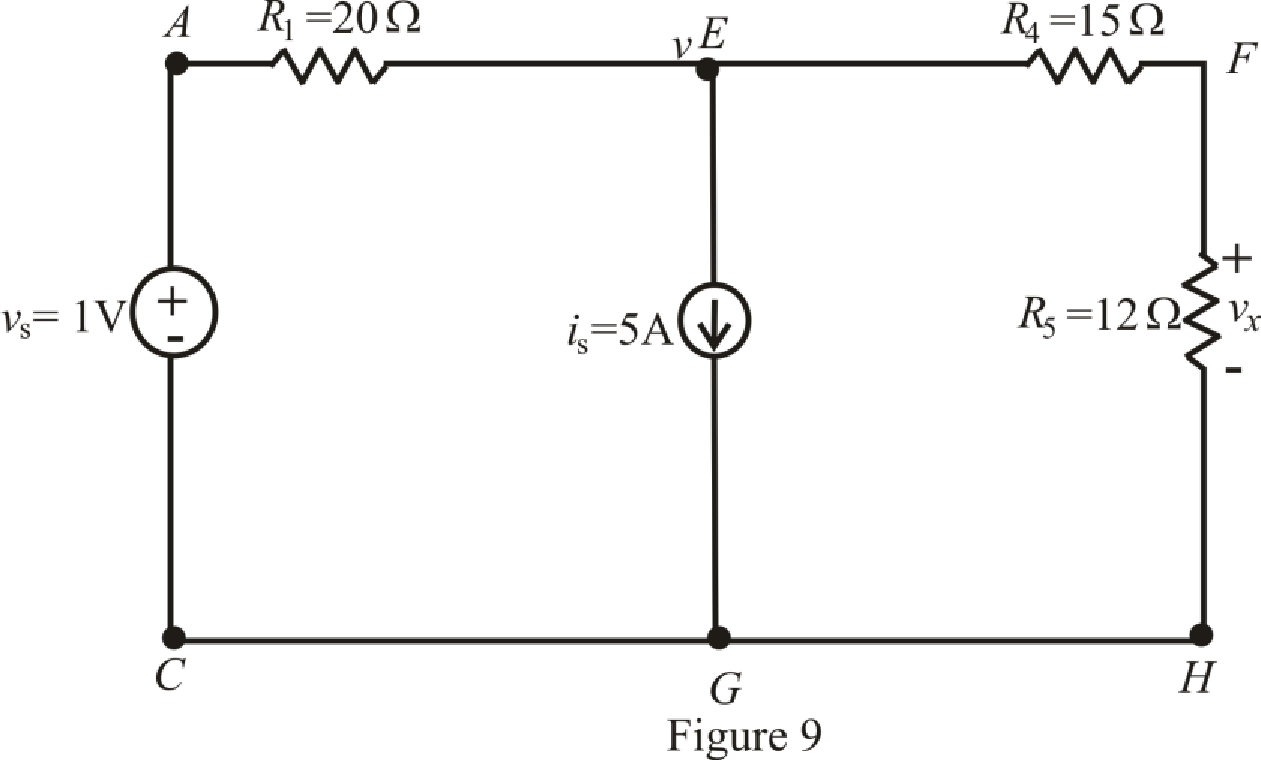
Refer to the Figure 9:
The expression for the nodal analysis at node voltage
The expression for the current across the resistance
The expression for the voltage across the resistance
The current across the resistances
Substitute
Solve for
Substitute
Substitute
Conclusion:
Thus, the voltage
(d)
Find the voltage
Answer to Problem 29E
The voltage
Explanation of Solution
Given Data:
Value of inductor connected between terminal
Value of resistor connected in parallel with inductor across terminal
Calculation:
The redrawn circuit is shown in Figure 10:
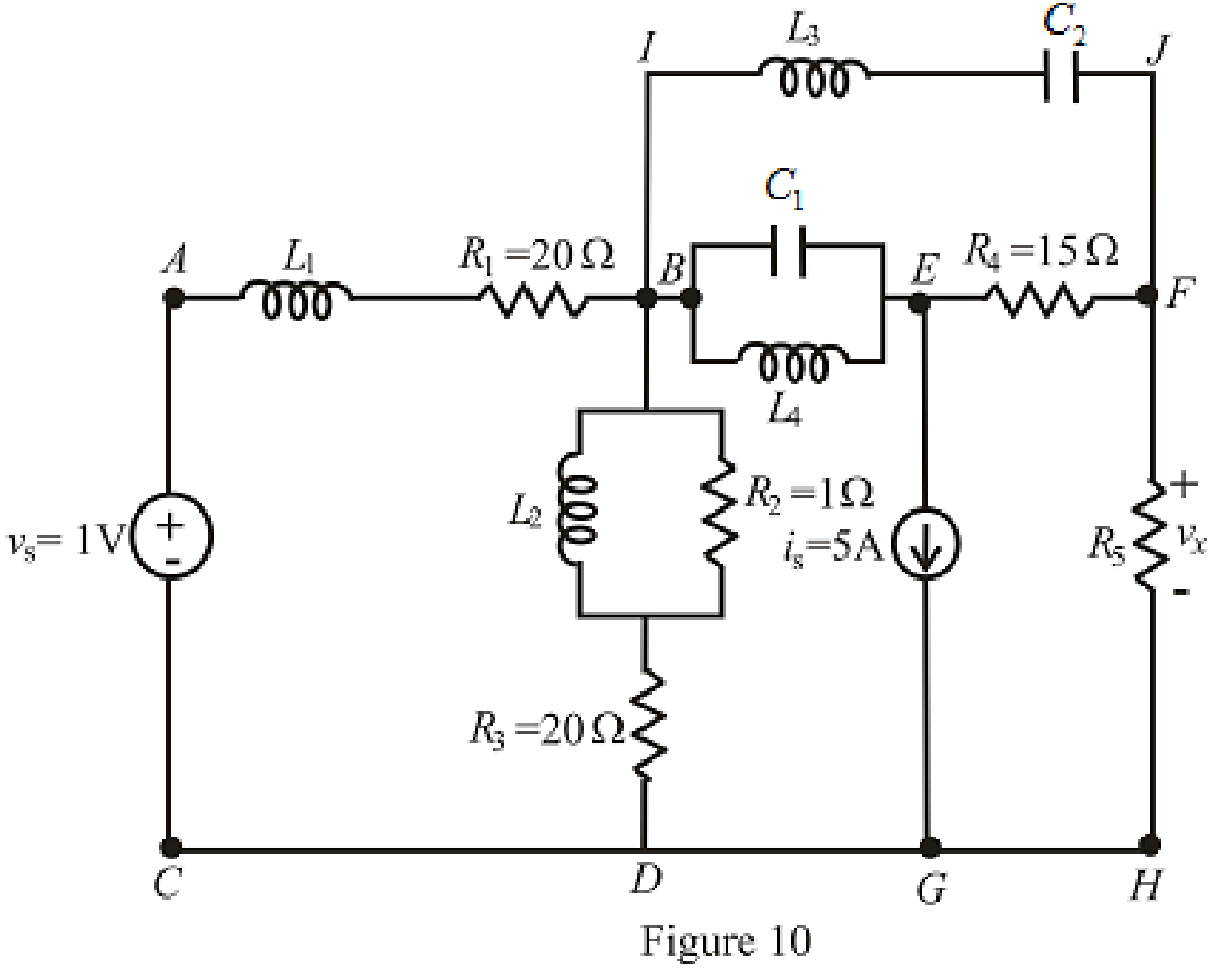
Refer to the redrawn Figure 10:
The redrawn circuit is shown in Figure 11 as follows:
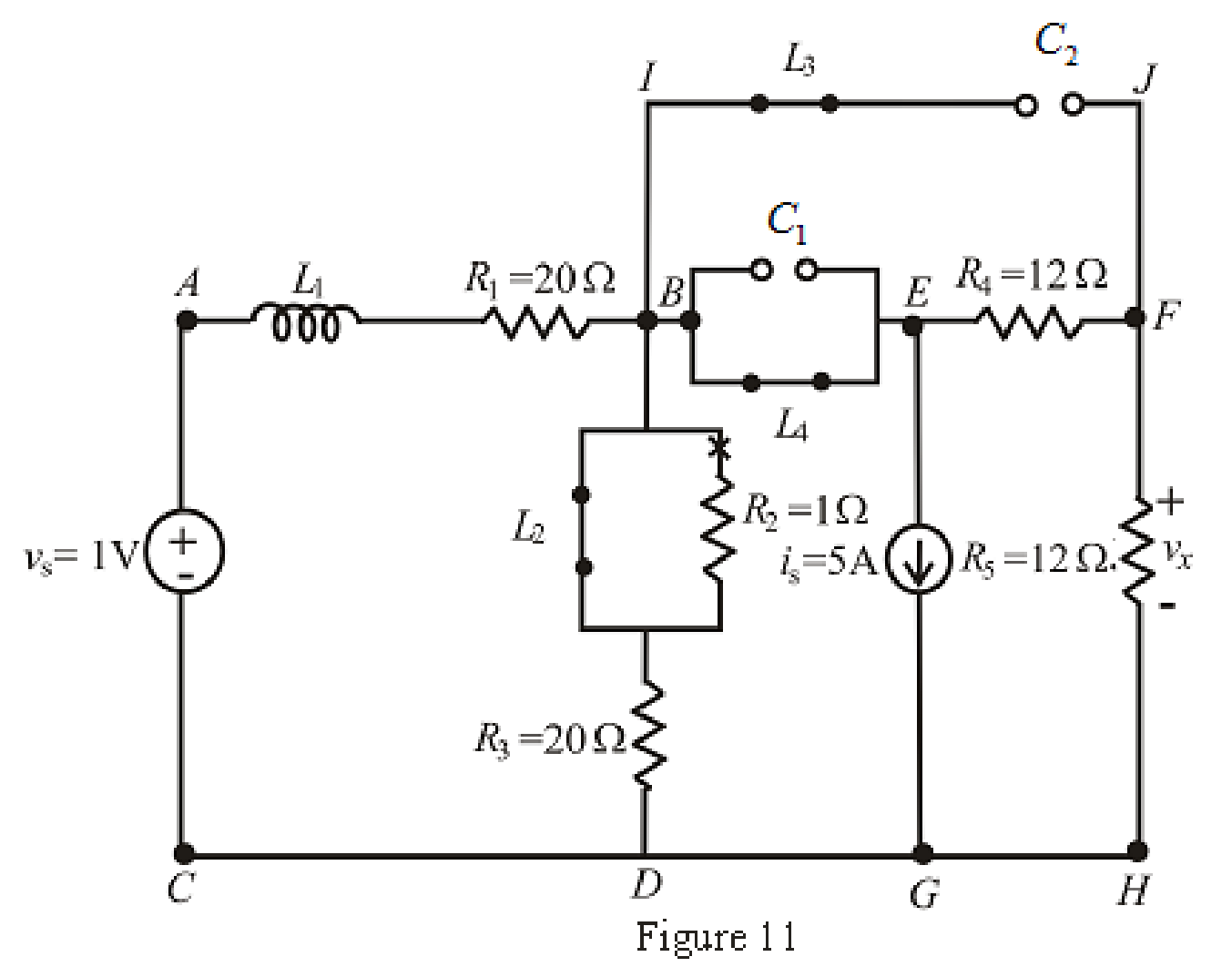
When steady state is reached, the inductor connected across branch
The redrawn circuit is shown in Figure 12,

Refer to the Figure 12:
The expression for the nodal analysis at node voltage
The expression for the current across the resistance
The expression for the voltage across the resistance
The current across the resistances
Substitute
Solve for
Substitute
Substitute
Conclusion:
Thus, the voltage
Want to see more full solutions like this?
Chapter 7 Solutions
Engineering Circuit Analysis
- circuit analysissource transform step by step in the most basic formvo findarrow_forwardCompute the Laplace transform of the following time domain function using only L.T. properties: f(t)=(t-3)eu(t − 2)arrow_forwardcircuit analysisuse source Transform and step by step in the most basic formarrow_forward
- Not: I need also pictures cct diagram and result Question: I need a MATLAB/Simulink model for a Boost Converter used to charge a battery, powered by a PV solar panel. The model should include: 1. A PV solar panel as the input power source. 2. A Boost Converter circuit for voltage regulation. 3. A battery charging system. 4. Simulation results showing voltage, current, and efficiency of the system. Important: Please provide: 1. The Simulink file of the model. 2. Clear screenshots showing the circuit connections in MATLAB/Simulink. 3. Screenshots of the simulation results (voltage, current, efficiency, etc.).arrow_forwardA Butterworth low-pass filter has the following specification: max = 0.5 dB, min =30dB p = 750rad/s and s = 1750rad/si) Determine the TF for Butterworth LP filterii) Q of the polesiii) Determine the half-power frequency 0iv) Determine the actual attenuation at the edge of the pass-band and the edge of the stop-band, (p) and (s).arrow_forwardFind the inverse of Laplace transform s-1 5+5 , Re[s]>-3 (s+1)(s-3) s+5 a) s²(s+3) b) c) (S-1)(s+1)2 d) s+5 , i) Re[s]> 3 ii) Re[s]-1 ii) Re[s] 1 (s-1)(s-2)(s-3)' , i) Re[s]> 3 ii) Re[s]<1 iii) Iarrow_forward1- Find the Laplace transform and the corresponding ROC of the following signals. a) x(t) = [et + et cos(3t)]u(t) b)x(t) = e-alte-atu(t) + eatu(-t), consider a>0. c) x(t)=8(t) +8(t-1)+8(t−2) d) x(t) = u(-1)-u(1) e) x(t) = e-³t sin(2t)u(t)dr f)x(t) =[r³ +sin(2t)]u(t)dt g)x(t)=t2e2 cos(5t) u(t - 1)arrow_forwardThe transfer function of causal LTI system is H(s) = s+1 (s+1)(s+3) Determine the response y(t) when the input x(t) = elt, for the following region of convergence :) Re[s]> -3 ii) Re[s]Re[s]> -3arrow_forwardConsider the signal y(t) = x₁(t-2) x2(-t + 3) where x₁(t) = e−2tu(t) and x2(t) = eu(t). Determine the Laplace transform of y(t) using the properties. Also find the ROC.arrow_forwardConsider the LTI system with the input x(t) = eu(t) and the impulse response h(t) = e−2tu(t). a) Determine the Laplace transform of x(t) and h(t). b) Using convolutional property, determine the Laplace transform of the output y(t). Find the ROC for each case.arrow_forward2) a) Plot the voltage transfer characteristic of the circuit below. Assume diode and zener are ideal with VDon=0V (20Pts) view 1K 1, B-100, VBE =0,7V ovo VCEsat = 0V, 2K It 10 V 8V zenerarrow_forwardcircuit dchow find vth step by step rth find RL that enables the circuit to deliver maximum power to terminal then plot norton cırcuitarrow_forwardarrow_back_iosSEE MORE QUESTIONSarrow_forward_ios
 Introductory Circuit Analysis (13th Edition)Electrical EngineeringISBN:9780133923605Author:Robert L. BoylestadPublisher:PEARSON
Introductory Circuit Analysis (13th Edition)Electrical EngineeringISBN:9780133923605Author:Robert L. BoylestadPublisher:PEARSON Delmar's Standard Textbook Of ElectricityElectrical EngineeringISBN:9781337900348Author:Stephen L. HermanPublisher:Cengage Learning
Delmar's Standard Textbook Of ElectricityElectrical EngineeringISBN:9781337900348Author:Stephen L. HermanPublisher:Cengage Learning Programmable Logic ControllersElectrical EngineeringISBN:9780073373843Author:Frank D. PetruzellaPublisher:McGraw-Hill Education
Programmable Logic ControllersElectrical EngineeringISBN:9780073373843Author:Frank D. PetruzellaPublisher:McGraw-Hill Education Fundamentals of Electric CircuitsElectrical EngineeringISBN:9780078028229Author:Charles K Alexander, Matthew SadikuPublisher:McGraw-Hill Education
Fundamentals of Electric CircuitsElectrical EngineeringISBN:9780078028229Author:Charles K Alexander, Matthew SadikuPublisher:McGraw-Hill Education Electric Circuits. (11th Edition)Electrical EngineeringISBN:9780134746968Author:James W. Nilsson, Susan RiedelPublisher:PEARSON
Electric Circuits. (11th Edition)Electrical EngineeringISBN:9780134746968Author:James W. Nilsson, Susan RiedelPublisher:PEARSON Engineering ElectromagneticsElectrical EngineeringISBN:9780078028151Author:Hayt, William H. (william Hart), Jr, BUCK, John A.Publisher:Mcgraw-hill Education,
Engineering ElectromagneticsElectrical EngineeringISBN:9780078028151Author:Hayt, William H. (william Hart), Jr, BUCK, John A.Publisher:Mcgraw-hill Education,





